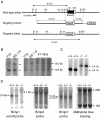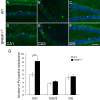Absence of BRINP1 in mice causes increase of hippocampal neurogenesis and behavioral alterations relevant to human psychiatric disorders
- PMID: 24528488
- PMCID: PMC3928644
- DOI: 10.1186/1756-6606-7-12
Absence of BRINP1 in mice causes increase of hippocampal neurogenesis and behavioral alterations relevant to human psychiatric disorders
Abstract
Background: We have previously identified BRINP (BMP/RA-inducible neural-specific protein-1, 2, 3) family genes that possess the ability to suppress cell cycle progression in neural stem cells. Of the three family members, BRINP1 is the most highly expressed in various brain regions, including the hippocampus, in adult mice and its expression in dentate gyrus (DG) is markedly induced by neural activity. In the present study, we generated BRINP1-deficient (KO) mice to clarify the physiological functions of BRINP1 in the nervous system.
Results: Neurogenesis in the subgranular zone of dentate gyrus was increased in BRINP1-KO mice creating a more immature neuronal population in granule cell layer. The number of parvalbumin expressing interneuron in hippocampal CA1 subregion was also increased in BRINP1-KO mice. Furthermore, BRINP1-KO mice showed abnormal behaviors with increase in locomotor activity, reduced anxiety-like behavior, poor social interaction, and slight impairment of working memory, all of which resemble symptoms of human psychiatric disorders such as schizophrenia and attention-deficit/hyperactivity disorder (ADHD).
Conclusions: Absence of BRINP1 causes deregulation of neurogenesis and impairments of neuronal differentiation in adult hippocampal circuitry. Abnormal behaviors comparable to those of human psychiatric disorders such as hyperactivity and poor social behavior were observed in BRINP1-KO mice. These abnormal behaviors could be caused by alteration of hippocampal circuitry as a consequence of the lack of BRINP1.
Figures









Similar articles
-
Brinp1(-/-) mice exhibit autism-like behaviour, altered memory, hyperactivity and increased parvalbumin-positive cortical interneuron density.Mol Autism. 2016 Mar 31;7:22. doi: 10.1186/s13229-016-0079-7. eCollection 2016. Mol Autism. 2016. PMID: 27042284 Free PMC article.
-
Decreased parvalbumin and somatostatin neurons in medial prefrontal cortex in BRINP1-KO mice.Neurosci Lett. 2018 Sep 14;683:82-88. doi: 10.1016/j.neulet.2018.06.050. Epub 2018 Jun 28. Neurosci Lett. 2018. PMID: 29960053
-
Increased anxiety-like behavior and selective learning impairments are concomitant to loss of hippocampal interneurons in the presymptomatic SOD1(G93A) ALS mouse model.J Comp Neurol. 2015 Aug 1;523(11):1622-38. doi: 10.1002/cne.23759. Epub 2015 Apr 7. J Comp Neurol. 2015. PMID: 25684566
-
Is Adult Hippocampal Neurogenesis Really Relevant for the Treatment of Psychiatric Disorders?Curr Neuropharmacol. 2021;19(10):1640-1660. doi: 10.2174/1570159X18666200818194948. Curr Neuropharmacol. 2021. PMID: 32811415 Free PMC article. Review.
-
Epigenetics, hippocampal neurogenesis, and neuropsychiatric disorders: unraveling the genome to understand the mind.Neurobiol Dis. 2010 Jul;39(1):73-84. doi: 10.1016/j.nbd.2010.01.008. Epub 2010 Jan 28. Neurobiol Dis. 2010. PMID: 20114075 Free PMC article. Review.
Cited by
-
Dysfunction of Trio GEF1 involves in excitatory/inhibitory imbalance and autism-like behaviors through regulation of interneuron migration.Mol Psychiatry. 2021 Dec;26(12):7621-7640. doi: 10.1038/s41380-021-01109-x. Epub 2021 May 7. Mol Psychiatry. 2021. PMID: 33963279
-
Chronic chemogenetic activation of hippocampal progenitors enhances adult neurogenesis and modulates anxiety-like behavior and fear extinction learning.IBRO Neurosci Rep. 2024 Jan 22;16:168-181. doi: 10.1016/j.ibneur.2024.01.002. eCollection 2024 Jun. IBRO Neurosci Rep. 2024. PMID: 39007086 Free PMC article.
-
How Staying Negative Is Good for the (Adult) Brain: Maintaining Chloride Homeostasis and the GABA-Shift in Neurological Disorders.Front Mol Neurosci. 2022 Jul 8;15:893111. doi: 10.3389/fnmol.2022.893111. eCollection 2022. Front Mol Neurosci. 2022. PMID: 35875665 Free PMC article. Review.
-
Structured Genome-Wide Association Studies with Bayesian Hierarchical Variable Selection.Genetics. 2019 Jun;212(2):397-415. doi: 10.1534/genetics.119.301906. Epub 2019 Apr 22. Genetics. 2019. PMID: 31010934 Free PMC article.
-
An updated review on animal models to study attention-deficit hyperactivity disorder.Transl Psychiatry. 2024 Apr 11;14(1):187. doi: 10.1038/s41398-024-02893-0. Transl Psychiatry. 2024. PMID: 38605002 Free PMC article. Review.
References
-
- Kawano H, Nakatani T, Mori T, Ueno S, Fukaya M, Abe A, Kobayashi M, Toda F, Watanabe M, Matsuoka I. Identification and characterization of novel developmentally regulated neural-specific proteins, BRINP family. Brain ResMolBrain Res. 2004;125:60–75. doi: 10.1016/j.molbrainres.2004.04.001. - DOI - PubMed
-
- Terashima M, Kobayashi M, Motomiya M, Inoue N, Yoshida T, Okano H, Iwasaki N, Minami A, Matsuoka I. Analysis of the expression and function of BRINP family genes during neuronal differentiation in mouse embryonic stem cell-derived neural stem cells. J Neurosci Res. 2010;88:1387–1393. - PubMed
Publication types
MeSH terms
Substances
LinkOut - more resources
Full Text Sources
Other Literature Sources
Medical
Molecular Biology Databases
Research Materials
Miscellaneous

